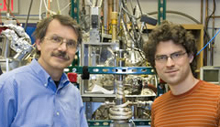Today
Noon
Environmental Energy Technologies
Looking Past the Trellis: An Insider's View of Oberlin's Green Academic Building
John Scofield, Oberlin College
Bldg. 90-3122
1:30 p.m.
Materials Sciences
Investigation of Ice/Vapor and Solution/Vapor Interfaces Using Ambient Pressure Photoemission Spectroscopy
Hendrik Bluhm
Bldg. 66 Auditorium
Tomorrow
9:30 a.m.
Virtual Institute of Microbial Stress and Survival
Two Topics in Comparative Genomics: Methionine Synthesis and the Evolution and Annotation of Transcription Factors
Morgan Price
Bldg. 977 Sudar Auditorium (Potter Street)
10 to 11:30 a.m.
Benefits Office
Open Enrollment Meeting
Bldg. 50 Auditorium
11 a.m.
Advanced Light Source
Vortex Dynamics in Patterned Magnetic Thin Films
Sang-Koog Kim, Seoul National U.
Bldg. 6-2202
Noon
Environmental Energy Technologies
US-India Partnership in S&T, Environment and Health
Satish Kulkarni, U.S. Embassy in New Delhi, India
Bldg. 90-3122
Noon
Yoga Club
Class with Naomi Hartwig
Bldg. 70-191
Noon
Dance Club
Ballroom Dance Party
Bldg. 51 Lobby
1 p.m.
Scientific Computing
Image Segmentation With Optimization Techniques Used for Medical Imaging
Dorit Hochbaum, UC Berkeley
Bldg. 50F-1647
2 p.m.
Nano Institute
Reaction Chemistry Meets Lithography
Colin Nuckolls, Columbia U.
390 Hearst Mining Bldg.
2 to 3:30 p.m.
Benefits Office
Open Enrollment Meeting
Bldg. 50 Auditorium |
|
 |
|
|
 |
|
| |
Breakfast: Strawberry Cinnamon French Toast and Sausage
Tomorrow's Breakfast: Corned Beef Hash with Eggs and Hash Browns
Pizza: Double Crust Stuffed Pepperoni
Grill: Beef Quesadilla with Sour Cream and Salsa
Deli: Italian Combo
Carvery: Gyro Greek Salad
Cultural Cuisines: Sweet and Sour Pork
| B'fast: |
6:30
a.m. - 9:30 a.m. |
| Lunch: |
11
a.m. - 1:30 p.m. |
| Full
menu |
| |
|
|
|
 |
|
 |

Solar Energy Boom
May Help the Poor
By Gerard Wynn
A surge in investment in solar power is bringing down costs of the alternative energy source, but affordability problems still dog hopes for the 1.6 billion people worldwide without electricity. A worldwide scientific body said last week efforts to curb climate change must target vast numbers of people who lack basic energy. "It's sad that 1.6 billion people live without electricity and two to three billion use energy in a primitive way very damaging to health," said Berkeley Lab Director Steve Chu, a co-chair of the report for the Dutch-based body. Full story.

Chemistry Classes Behind
The Bars at San Quentin
By Linda Wang
A recent story in Chemical and Engineering News features Berkeley Lab materials scientist and UC Berkeley graduate student Charles Crawford who, along with fellow Lab scientists Michael Rousseas and Erik Douglas, teaches chemistry to San Quentin inmates. The instructors say the prisoners are some of the most motivated and hard-working students they have ever taught. The prisoners, in turn, say that these volunteers have inspired them to work hard and seek a better life for themselves. Full story.
 |
 |
|
 |
Dance Club Hosts
Party Tomorrow
Berkeley Lab’s Ballroom Dance Club will host a party tomorrow at noon in the lobby of Building 51 (Bevatron). All employees are invited to attend and dance, no partners required. The club will begin new lessons next week, with beginning East Coast Swing on Mondays and intermediate Rumba on Wednesdays. Staff can purchase tickets to the club’s holiday party, on Saturday, Dec. 8, during the noontime lessons.
 |
 |
|
 |
|
 |
|
 |
|
Zettl, left and UC Berkeley student Kenneth Jensen |
|
First Fully Functional Nanotube Radio Created
Make way for the real “nanopod” and make room in the Guinness Book of World Records. A team of researchers at Berkeley Lab and UC Berkeley has created the first fully functional radio from a single carbon nanotube, which makes it by several orders of magnitude the smallest radio ever made. “A single carbon nanotube molecule serves simultaneously as all essential components of a radio — antenna, tunable band-pass filter, amplifier, and demodulator,” said physicist Alex Zettl, who led the research. “Using carrier waves in the commercially relevant 40-400 MHz range and both frequency and amplitude modulation (FM and AM), we were able to demonstrate successful music and voice reception.” Go here to read the full story, which includes video of sound (Star Wars theme) recorded on the nanotube radio.

|  |
|
 |
New System Manages
Aerosol Can Waste
The Facilities and Environment, Health and Safety Divisions have acquired a system to manage waste aerosol cans. The aerosol waste is collected in a drum, and the empty cans are sent to the metal salvage hopper for metals recycling. The consolidated contents of the aerosol cans are managed as hazardous waste. This method eliminates the need to manage aerosol cans as hazardous waste and saves time for EH&S staff and users. The system can only be used by trained personnel. Employees with aerosol cans for disposal should contact Mark Lasartemay at x6825 for evaluation. More information about managing wastes can be found here.

|
 |
|
 |
Office of Science’s
Dehmer Promoted
Patricia Dehmer, formerly the Associate Director for Basic Energy Sciences in the Office of Science, has been appointed as the Deputy Director for Science Programs. The Office of Science will now have three deputy directors: Science Programs, Resource Management and Operations, all reporting directly to Director Raymond Orbach. Full story.
 |
 |
|
|
|
|
Jack-o-Lantern Honors
Berkeley
Lab's 76 Years
Life scientist Henry Marr, a member of Division Director Joe Gray's lab, stayed up until the wee hours of the morning yesterday carving this halloween homage to the Lab's 76 years of existence. |
|
|
 |
|
|
|
|
 EMERGENCY INFO EMERGENCY INFO |
 |
Emergency: Call x7911
Cell Phones: Call 911
Non-emergency Incident Reporting: Call x6999
SECON level 3
More Information |
 |
|
|
 |
|
|

